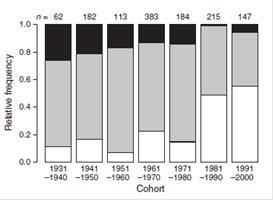
We have recently worked on a formerly exploited marine fish that is currently of conservation concern following a steady decline in population abundance. The species is white hake and work by postdoctoral fellow Denis Roy showed that fish living in deep waters are genetically distinguishable from those living in shallower waters even though they all inhabit the same fisheries management region, a finding that has direct implications for the design of conservation and recovery strategies for this species. [Roy et al (2012) Can J Fish Aquat Sci. 69: 414 - 429]

Harvesting marine fish has long been argued to be a strong agent of selection and a number of studies have described phenotypic or life history changes in response to harvesting. In a collaborative effort with Icelandic colleagues we recently published a study led by PhD student Klara Jakobsdottir, which used a 60 year long genetic data set to demonstrate molecular genetic changes in a heavily exploited cod stock off Iceland. Changes in allele frequencies were observed in a functional gene that in Icelandic cod is linked to growth rate while no changes were observed in neutral microsatellite markers over the same 60 yr period. These results are consistent with an evolutionary response to intense size-selective harvesting! [Jakobdottir et al (2011) Evolutionary Applications 4: 562- 573]

Salmonid species tend to live in spatially structured and geographically fragmented systems often interconnected by gene flow. In some of the work on Atlantic salmon conducted with former PhD student Friso Palstra in which we used historical and contemporary samples, we showed that the direction of gene flow among neighbouring populations changed depending on the time frame of interest. This finding suggests that what may be considered sink populations in the present may not have been such in the past and cautions against prioritizing populations for conservation based exclusively on contemporary patterns of connectivity. [Palstra et al (2007) Mol Ecol 16: 4504-4522]

In our work on Patagonian fish phylogeography with former PhD student Tyler Zemlak, we found that molecular genetics could tell us stories of river capture and drainage reversal events across the Patagonian Andes. As glaciers melted following the Last Glacial Maximum some 20 000 years ago, such episodes of drainage reversals from the Atlantic to the Pacific Ocean likely occurred several times and in different places along the Patagonian Andean Cordillera. [Zemlak et al (2008) (2011) ME & (2010) BMC Evol Biol]